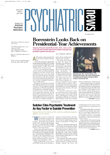As the number of tragedies in which American students are engaging in school shootings or other acts of violence increases, psychiatrists are trying to stop them. And making some progress, it appears.
For instance, Carl Bell, M.D., president and CEO of the Community Mental Health Council and Foundation Inc. in Chicago, seems to be making some inroads against violence in Chicago’s public schools (Psychiatric News, September 15, 2000).
And now Stuart Twemlow, M.D., a psychiatrist with the Austen Riggs Center in Stockbridge, Mass., and his colleagues have devised a violence-intervention program for elementary-school children that appears to be making a difference. They reported their findings in the May American Journal of Psychiatry.
The program has several aspects to it. First, during gym class, youngsters and teachers practice playing different roles in “bully-victim-bystander” dramas so that each group better understands the psychological dynamics involved. Say, a child throws a spitball at a teacher and hits her; she turns around and sends him to the principal; meanwhile, the other pupils watch the interaction and laugh. As children and teachers play these various roles, they start to realize that the spitball thrower is the bully, the teacher is the victim, and the laughing pupils are the bystanders.
A lot of other programs designed to prevent school violence, Twemlow explained to Psychiatric News, focus on the bullies, who, “in our opinion, get too much attention,” and not nearly enough on the bystanders. Yet “a bystanding audience sort of keeps this all going. That includes students, teachers, actually all people working in the school.”
A second aspect of the program is teaching youngsters in gym class how to handle bullies—not just with martial arts, but with some nonphysical techniques, such as simply walking away.
Yet a third phase of the program is teaching teachers how to discipline children without having to resort to punishment.
“What we are doing,” Twemlow said, “is giving the kids insight. And we are giving them physical skills. And social skills. We are also giving teachers a way of managing classrooms. . . .”
But Twemlow and his colleagues have not only designed an antiviolence intervention strategy, but also tested it as well. During a four-year period, the program was used in one inner-city elementary school with a lot of disciplinary problems and such serious fighting that the police had to be called in sometimes. The program was not employed in another inner-city elementary school with similar demographics and problems. The researchers then assessed the levels of violence in the two schools, both at the beginning of the study and at the end. The school that used the antiviolence program experienced a significant reduction in disciplinary referrals and cases of physical aggressiveness over the four years, they found. This was not so for the control school. What’s more, anecdotal reports from teachers in the experimental school suggested that many previously passive and withdrawn, victimized children often became more verbal and outspoken as the program progressed, and that the children in general had become more reflective and less inclined to bully.
Study results were so encouraging, in fact, that Twemlow and his team are now testing it in a larger study—a randomized, controlled investigation involving 11 elementary schools in Topeka, Kan. That study is at the halfway point. “Once we complete it,” Twemlow said, “I think we’ll have the best-controlled trial of a school antiviolence intervention that has been done so far.”
When he was asked whether any schools around the country have expressed interest in his program, Twemlow replied: “Oh, yes! I could give up psychiatry tomorrow and do this full time. I was just in St. Louis, where three schools are getting involved in the process; we also have money to start up a process in Miami-Dade County; as far as Houston is concerned, we’ll probably start there. And we have a $9 million project in the Springfield, Mass., school system.”
AM J PSYCHIATRY 2001 158 808
